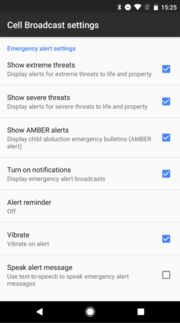Related Research Articles
The Universal Mobile Telecommunications System (UMTS) is a third generation mobile cellular system for networks based on the GSM standard. Developed and maintained by the 3GPP, UMTS is a component of the International Telecommunications Union IMT-2000 standard set and compares with the CDMA2000 standard set for networks based on the competing cdmaOne technology. UMTS uses wideband code division multiple access (W-CDMA) radio access technology to offer greater spectral efficiency and bandwidth to mobile network operators.
The GPRS core network is the central part of the general packet radio service (GPRS) which allows 2G, 3G and WCDMA mobile networks to transmit IP packets to external networks such as the Internet. The GPRS system is an integrated part of the GSM network switching subsystem.
The Radio Network Controller (RNC) is a governing element in the UMTS radio access network (UTRAN) and is responsible for controlling the Node Bs that are connected to it. The RNC carries out radio resource management, some of the mobility management functions and is the point where encryption is done before user data is sent to and from the mobile. The RNC connects to the Circuit Switched Core Network through Media Gateway (MGW) and to the SGSN in the Packet Switched Core Network.
Mobility management is one of the major functions of a GSM or a UMTS network that allows mobile phones to work. The aim of mobility management is to track where the subscribers are, allowing calls, SMS and other mobile phone services to be delivered to them.
In telecommunications networks, RANAP is a protocol specified by 3GPP in TS 25.413 and used in UMTS for signaling between the Core Network, which can be a MSC or SGSN, and the UTRAN. RANAP is carried over Iu-interface.
Control plane protocol for the transport layer in 3rd Generation UMTS networks is called ALCAP. ALCAP is defined by 3GPP as equivalent of ITU recommendation Q.2630.2. Basic functionality of ALCAP is multiplexing of different users onto one AAL2 transmission path using channel IDs (CIDs). It is used in the UMTS access network UTRAN along with ATM, while IPBCP is use for IP links in the core of the network.
In the 3GPP UTRAN architecture, NBAP is the signalling protocol responsible for the control of the Node B by the RNC. NBAP is subdivided into Common and Dedicated NBAP, where Common NBAP controls overall Node B functionality, and Dedicated NBAP controls radio links to specific user equipment. NBAP forms part of the Iub interface.

E-UTRA is the air interface of 3rd Generation Partnership Project (3GPP) Long Term Evolution (LTE) upgrade path for mobile networks. It is an acronym for Evolved Universal Mobile Telecommunications System (UMTS) Terrestrial Radio Access, also referred to as the 3GPP work item on the Long Term Evolution (LTE) also known as the Evolved Universal Terrestrial Radio Access (E-UTRA) in early drafts of the 3GPP LTE specification. E-UTRAN is the initialism of Evolved UMTS Terrestrial Radio Access Network and is the combination of E-UTRA, user equipment (UE), and E-UTRAN Node B or Evolved Node B (EnodeB).
Vertical handover or vertical handoff refers to a network node changing the type of connectivity it uses to access a supporting infrastructure, usually to support node mobility. For example, a suitably equipped laptop might be able to use both a high speed wireless LAN and a cellular technology for Internet access. Wireless LAN connections generally provide higher speeds, while cellular technologies generally provide more ubiquitous coverage. Thus the laptop user might want to use a wireless LAN connection whenever one is available, and to 'fall over' to a cellular connection when the wireless LAN is unavailable. Vertical handovers refer to the automatic fallover from one technology to another in order to maintain communication. This is different from a 'horizontal handover' between different wireless access points that use the same technology in that a vertical handover involves changing the data link layer technology used to access the network.

Cell Broadcast (CB) is a method of sending messages to multiple mobile telephone users in a defined area at the same time. It is defined by the ETSI’s GSM committee and 3GPP and is part of the 2G, 3G, 4G LTE (telecommunication) and 5G standards. It is also known as Short Message Service-Cell Broadcast (SMS-CB).

High Speed Packet Access (HSPA) is an amalgamation of two mobile protocols, High Speed Downlink Packet Access (HSDPA) and High Speed Uplink Packet Access (HSUPA), that extends and improves the performance of existing 3G mobile telecommunication networks using the WCDMA protocols. A further improved 3GPP standard, Evolved High Speed Packet Access, was released late in 2008 with subsequent worldwide adoption beginning in 2010. The newer standard allows bit-rates to reach as high as 337 Mbit/s in the downlink and 34 Mbit/s in the uplink. However, these speeds are rarely achieved in practice.
The Radio Resource Control (RRC) protocol is used in UMTS and LTE on the Air interface. It is a layer that exists between UE and eNB and exists at the IP level. This protocol is specified by 3GPP in TS 25.331 for UMTS and in TS 36.331 for LTE. RRC messages are transported via the PDCP-Protocol.
System Architecture Evolution (SAE) is the core network architecture of 3GPP's LTE wireless communication standard.
A Home Node B, or HNB, is the 3GPP's term for a 3G femtocell or Small Cell.
HNBAP is a control protocol found in Home Node B networks on the Iu-h interface.
A Home eNodeB, or HeNB, is the 3GPP's term for an LTE femtocell or Small Cell.
The UMTS channels are communication channels used by third generation (3G) wireless Universal Mobile Telecommunications System (UMTS) networks. UMTS channels can be divided into three levels:
E-UTRAN Node B, also known as Evolved Node B, is the element in E-UTRA of LTE that is the evolution of the element Node B in UTRA of UMTS. It is the hardware that is connected to the mobile phone network that communicates directly wirelessly with mobile handsets (UEs), like a base transceiver station (BTS) in GSM networks.
A bearer service is a link between two points, which is defined by a certain set of characteristics. Whenever a user equipment (UE) is being provided with any service, the service has to be associated with a Radio Bearer specifying the configuration for Layer-2 and Physical Layer in order to have its QoS clearly defined. Radio bearers are channels offered by Layer 2 to higher layers for the transfer of either user or control data. In other words, Layer 2 offers to the upper layers the service of information transmission between the UE and the UTRAN by means of the Radio Bearers (RBs) and Signaling Radio Bearers (SRBs). Therefore, the service access points between Layer 2 and upper layers are RBs.
Fast Dormancy, or FD, is a mobile technology feature designed to reduce battery consumption and network utilization between mobile devices and their respective carrier networks during periods of data inactivity. It is currently implemented by monitoring the activity level of the mobile device and setting it to a control channel and power state appropriate for its level of activity. Each state results in different power consumption and network throughput while allowing a consistent data connection to be maintained. It is standardized by the 3rd Generation Partnership Project (3GPP) and implemented by most mobile carriers as a standard feature. Fast Dormancy is required to be supported by both the device and the carrier network in order for it to function.
References
- ↑ 3GPP TS 25.423 3GPP TS 25.423 Technical Specification Group Radio Access Network; UTRAN Iur interface RNSAP signalling